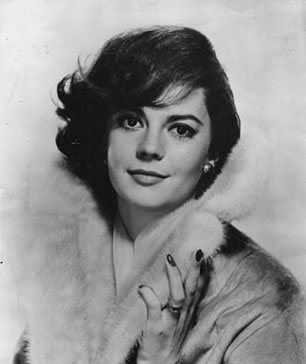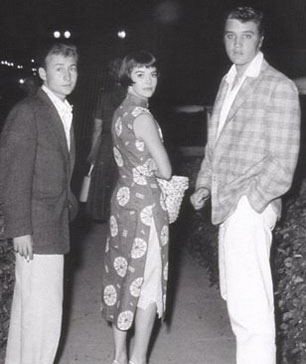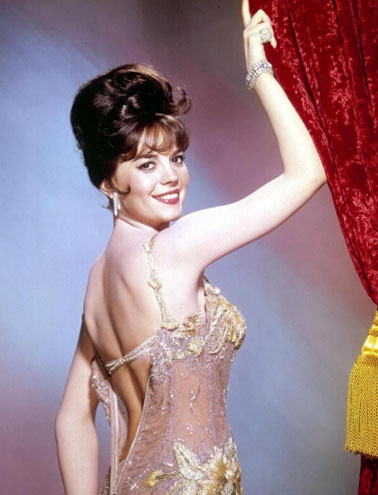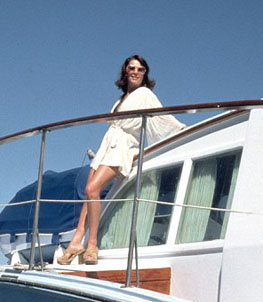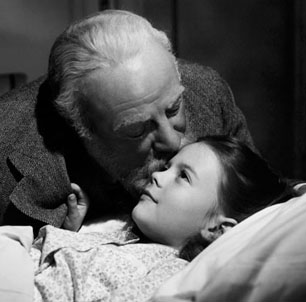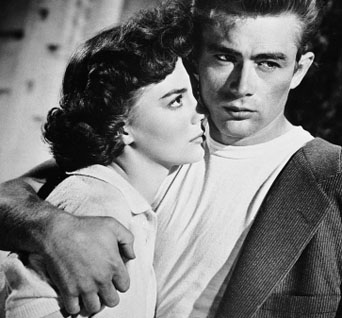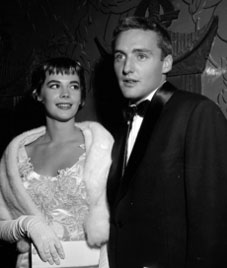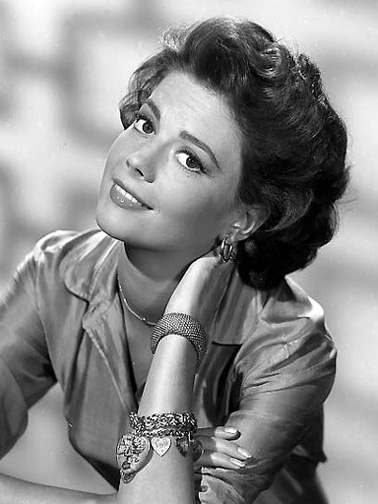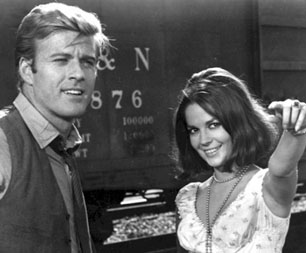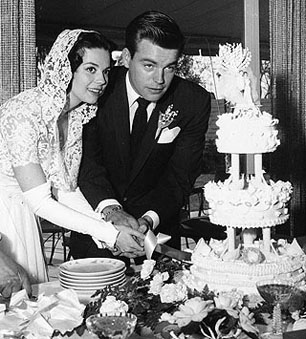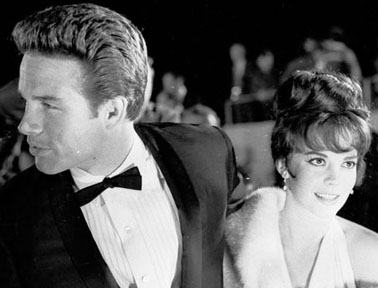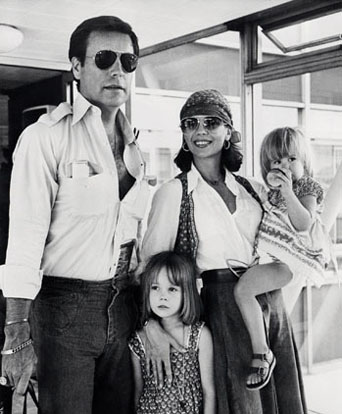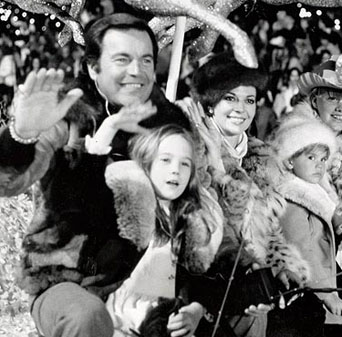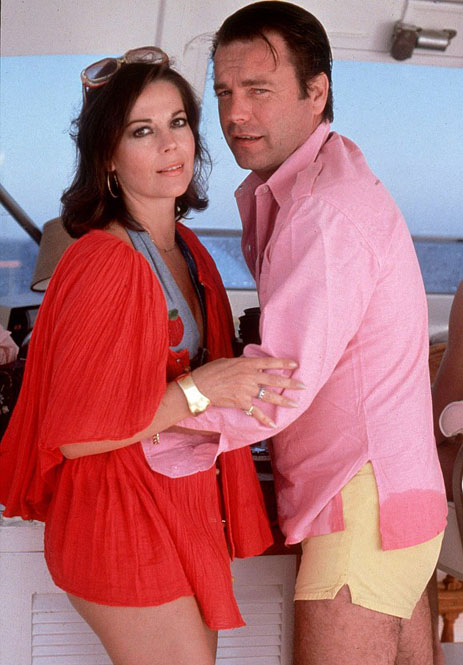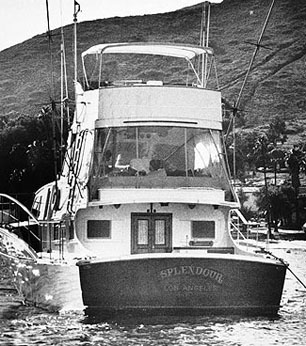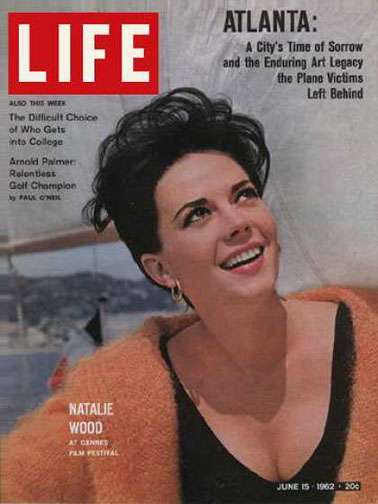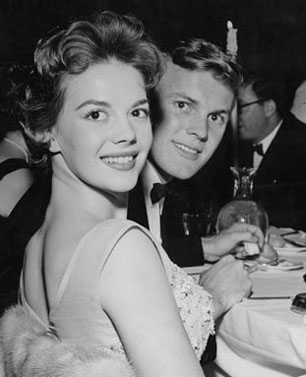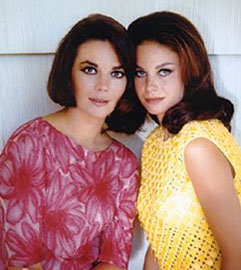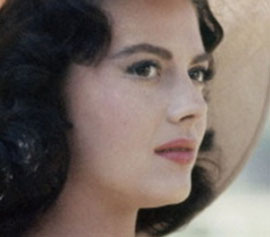Splendor at the Hollywood theatre : remembering the Natalie Wood who would be 73 years old ..
Nov 29th, 2011 | By L. Frank Bunting | Category: Entertainment[UPDATED WEDNESDAY, JANUARY 11, AUGUST 22, 2012 ; TUESDAY, NOVEMBER 29, 2016 : scroll to bottom of page]. Tuesday, November 29, 2011 marks the 30th anniversary of the death of Natalie Wood, aka Natalia Zakharenko, aka Natasha Gurdin, aka Natalie Wood Wagner – “a movie star, from probably the last period when stars were still icons and not like other people.”
As if to somehow commemorate the occasion, just a dozen days ago the Los Angeles County Sheriff’s Department announced that it was re-opening its investigation into Ms. Wood’s drowning, “while boating off the Isthmus of Catalina Island.” (For those whose memories go back much further again, this is the same island off the Los Angeles coast made famous by the Four Preps’ 1958 hit parade classic, “26 Miles.”)
In the late 1970s, a few years before Ms. Wood’s untimely and unhappy death, I was discussing movie stars with some over-urbane colleagues on a backwoods business trip. I confessed that she was my favourite, and was attacked for crass, plebeian taste. My colleagues held views that I heard again much more recently on the Turner Classic Movies channel, when Alec Baldwin told Robert Osborne that he felt “50/50” about Natalie Wood’s real acting ability – though no one could doubt her stature as a movie star.
Whatever the deepest truth on this front may be, my best more or less recent evidence for her worthiness as an object of serious intellectual admiration, I think, is the late John Gregory Dunne’s review of Gavin Lambert’s book Natalie Wood: A Life, in the January 15, 2004 issue of the New York Review of Books. Dunne and his wife, the surviving Joan Didion, saw Natalie Wood and her husband Robert Wagner socially from time to time. And he reported that:
“She was fun to be with and extremely perceptive. She was also as acute about the business of Hollywood as anyone we knew, aware of her own worth and the worth of everyone else … Like most people in the movie industry, she was an enthusiastic gossip; she not only knew where all the bodies were buried, but under how much dirt.”
I can’t quite imagine myself just where the Los Angeles County Sheriff’s Department’s 2011 re-opening of its investigation into Natalie Wood’s 1981 drowning while boating off the Isthmus of Catalina Island might lead.
John Gregory Dunne’s 2004 conclusion on this subject still finally seems convincing to me: “What happened will probably never be known. Everyone was too drunk, the two survivors [Robert Wagner and Christopher Walken] assaulted by guilt and memories best forgotten.”
But the immediate mindless reaction I contributed to the comments section of the innovative news website where I first heard about the reopened investigation was “About time.” And on further reflection I guess that if the Los Angeles County Sheriff’s Department’s decision leads we the vast unwashed mass public and movie audience to reacquaint ourselves with the legacy of Natalie Wood in her golden age, then it will all be worthwhile.
1. My favourite movie star: sketches for a desktop portrait …
Natalia Nikolaevna Zacharenko was born in San Francisco on July 20, 1938 to Russian immigrant parents. Her father of record, Nikolai Zacharenko, subsequently called himself Nick Gurdin. And in her early childhood the future Natalie Wood was known as Natasha Gurdin.
At the same time, her mother, Maria Zudilov, had what John Gregory Dunne called “a highly developed erotic sense.” As explained by the movie critic Philip French, “though she was never to know it” herself, Natalie Wood’s “real father was almost certainly a brutish Russian-born captain in the American merchant navy with whom Maria conducted a lifelong affair.”
Maria Gurdin (nee Zudilov) was also “a manipulative monster, even worse than the stage mother Rosalind Russell played to Wood’s Gypsy Rose Lee in [the 1962 movie] Gypsy.” In Russia before the 1917 revolution, Maria had come from a wealthy enough pro-tsarist family. In an effort to recover what she had lost in her new American home, she turned her daughter Natasha Gurdin into a leading child actress in the Hollywood of the big studio era.
Natasha’s first 15-second part was in a 1943 movie called Happy Land, just before her fifth birthday. She acquired the stage name “Natalie Wood” in her third movie, Tomorrow Is Forever, in 1946. The name was “bestowed on her by the movie’s producers as a gesture to their friend Sam Wood … who is perhaps best remembered for relentlessly rooting out Communist influences in Hollywood films and writing” (John Gregory Dunne).
Natalie Wood and Elizabeth Taylor
The still quite young Natalie Wood’s appearance in “the 1947 Christmas classic Miracle on 34th Street … made her one of the top child stars in Hollywood. Within a few months after the film’s release, Wood was so popular that Macy’s invited her to appear in the store’s annual Thanksgiving Day parade.”
All told the child actress Natalie Wood appeared in 20 movies, ending with Paul Newman’s debut costume drama of 1954, The Silver Chalice, in which (in the words of Gavin Lambert) “Natalie (with fourteenth billing) played Helena, a teenage slave girl who grows up to become Virginia Mayo.”
Most child actresses in the Hollywood big studio era (Shirley Temple, Peggy Ann Gardner, Margaret O’Brien, eg) did not go on to become successful adult actresses. The two big exceptions were Elizabeth Taylor and Natalie Wood. And they seem to have bonded in celebration of their shared achievement.
At “the Wagner house” after Natalie’s funeral in the late fall of 1981: “In the absence of a hostess, Elizabeth Taylor greeted every guest as they came through the door, clasping each to her substantial bosom and intoning mysteriously, ‘I am Mother Courage’” (John Gregory Dunne, yet again, who went there with his wife “to pay our respects”).
Rebelling without a cause
Maria Gurdin was also at the funeral in the late fall of 1981 (which began with a “brief Russian Orthodox service”). She was “quietly moaning,” taking “her last bow as Natalie’s mother.”
Natalie in her adulthood was not sentimental about her mother. Someone once asked her what her father of record, Nick Gurdin, had died of. She replied, “My mother.”
The adult daughter nonetheless inherited her mother’s “highly developed erotic sense.” According to movie critic Phillip French: “Lambert uses that curious old-fashioned term ‘highly sexed’ to describe her.” John Gregory Dunne just says that she was “promiscuous,” and then elaborates: “She had a battalion of lovers up and down the Hollywood rank structure – officers, NCOs, enlisted men, straight, bisexual, gay.”
Her ultimate conquests would include “Warren Beatty, Steve McQueen, Frank Sinatra (who also appeared at her funeral with “his first wife Nancy” and “their children, Tina, Nancy, and Frank Jr”), and “Nicky Hilton, Elizabeth Taylor’s kinky, abusive, and alcoholic first husband” (and some kind of ancestor of the Paris Hilton we know so well today).
This side of the adult Natalie Wood’s career was apparently launched by a strategic affair with the “aging Heathcliff” Nicholas Ray, director of what has become the 1955 cult classic Rebel Without a Cause, starring the ill-fated James Dean. The affair began before she was cast in this movie, which took her from child star to young adult starlet, and for which she won a best supporting actress Academy Award nomination.
As a further sign of her talent in all contexts, acting and otherwise, once she had become part of the Rebel cast, and was still carrying on with the aging Mr. Ray, the still teenage Natalie Wood also took up with a youthful Dennis Hopper, who was in the movie in a supporting role as well. On his own later testimony to Gavin Lambert, Dennis Hopper was impressed by “the cool way she handled two simultaneous affairs” – and sad that “I never had a friend like Natalie again.”
The golden age
Male movie fans who are less than physical giants themselves may find it especially intriguing that even the full-grown adult Natalie Wood was a notably petite lady with a highly developed erotic sense – “barely five feet tall and weighing less than a hundred pounds.” (This is John Gregory Dunne’s language. The Internet Movie Database reports that she was “commonly listed as 5′ 3″ wearing heels in movie magazines, though her actual height was 5′ 0′.”)
Over the five years after her breakout role in Rebel Without a Cause, the petite adult Natalie Wood appeared in 10 movies – including The Girl He Left Behind (with Tab Hunter, one of her many gay male friends), The Searchers (with John Wayne), Marjorie Morningstar (maybe the first movie I personally remember her in), All the Fine Young Cannibals (with her first and third husband, Robert “RJ” Wagner), and Cash McCall (with James Garner, and another of her early movies that has stuck in my mind, perhaps because it seemed to display her heightened sexuality for mass middle-class consumption, in a way I still vaguely remember).
Then came her two classics of 1961 – the musical West Side Story, and her troubled and troubling failed romance with Warren Beatty, Splendor in the Grass (for which she won her second Academy Award nomination, and which I have another seminal memory of seeing her in at the Hollywood theatre in Toronto [1930—1999]).
The remainder of the 1960s was her golden age: Gypsy (1962, and a Golden Globe nomination for best actress) ; Love with the Proper Stranger (1963, and more Academy Award and Golden Globe nominations) ; Sex and the Single Girl (1964) ; Inside Daisy Clover (1965, another Golden Globe nomination and “perhaps her best film role,” according to John Gregory Dunne – I first saw this movie myself in Windsor, Ontario, across the river from Detroit, and found it puzzling) ; The Great Race (1965) ; Penelope (1966) ; This Property Is Condemned (1966, with Robert Redford, as in Inside Daisy Clover, and another Golden Globe nomination) ; and Bob & Carol & Ted & Alice (the 1969 tribute to the sexual revolution, which must have seemed pretty tame to a 31-year-old lady with a battalion of lovers up and down the Hollywood rank structure).
Her husband, child, strength, weakness, lover, and life
If Natalie Wood had just been yet another (to quote the late Mr. Dunne yet again) “promiscuous, insecure, talented, irrational, funny, generous, shrewd” and “occasionally unstable” Hollywood actress, who slept her way to fame and fortune, she would not be as interesting as she remains today. She also wanted to be something more than this, something closer to the life of the ordinary person in her audience, that her mother had never let her have.
The still somewhat mysterious key here, it seems clear enough, was her complex, deep, and recurrently tormented relationship with Robert “RJ” Wagner – which may or may not have played an important role in her death as well (not really I would say myself, right now).
According to legend (and RJ’s own much later testimony to Charlie Rose) : “When she was 10 years old, she came across a 19-year-old actor on the lot at Fox studios, and instantly fell in love with him. By the time she made Rebel Without A Cause, Robert Wagner’s fan mail was … , ‘second only to Marilyn Monroe’s’. They were married in 1957, and became one of the brightest star couples in Hollywood … ‘My husband, my child, my strength, my weakness, my lover, my life,’ Natalie Wood wrote of Robert Wagner a year into their marriage.”
For better or worse, this first marriage did not last. As the late Mr. Dunne explained : “They were Hollywood’s happiest couple right up to the moment the marriage foundered. It was for the usual reason: conflicting careers, his going south, hers headed for the stratosphere. Rage, drink, and infidelity were unmentionable side issues.” As Wikipedia puts it, Natalie and RJ “separated in June 1961 and divorced in April 1962.”
Over the next decade Natalie “attempted suicide (twice).” Both Natalie and RJ remarried to others and had a daughter each. In the end, however, neither of these second marriages worked. Early in 1972 they apparently bumped into each other at a Hollywood party, and the bright lights started flashing again. On July 16, 1972 they married each other for a second time.
I will let John Gregory Dunne take over yet again from here: “a year after that, they had a daughter Courtney [well, Courtney was conceived in the summer of 1973, it seems, but she wasn’t actually born until March 9, 1974]. It was as if second time lucky, two veterans of the Hollywood marital, sexual, and professional wars were now contented, at peace. Motherhood was the part she was playing now, and she gave herself over to it as completely as she had given herself over to stardom.”
2. November 29, 1981 … 26 miles across the sea …
Caught up in her new maternal role, Natalie Wood did not have a lot to do with the movie industry for much of the 1970s.
She made a cameo appearance as herself in the 1972 Robert Redford political movie, The Candidate. In 1973 both Natalie and RJ were in a TV movie called The Affair, in which she played a Courtney Patterson (the same first name as the couple’s daughter, born in March 1974).
In 1975 she was in Peeper – a now obscure retro detective flick with Michael Caine. In 1976 Natalie and RJ once again appeared together, this time in a TV version of Cat on a Hot Tin Roof, with Laurence Olivier as (an apparently not too convincing) Big Daddy and Maureen Stapleton as Big Mama.
Then, for the next two years, Natalie Wood remained in splendid isolation at her white-clapboard house with a white picket fence in Beverly Hills, happy (or so it seemed?) in her new role as what might now be called the beautiful MILF, Mrs. Robert Wagner.
The changing late 1970s ecology of Natalie and RJ
There is, however, another John Gregory Dunne story about the second edition of Mrs. Robert Wagner, hinting at more complex troubled waters ahead:
“In the late 1970s, my wife and I flew to San Francisco to meet with the Wagners about a screenplay idea a producer friend of ours and theirs wanted us to pitch to them. Nothing came of the meeting, but at a waterfront dinner in Sausalito, we became aware of a subtle change in the ecology of their lives. After his movie career crashed, RJ had turned to television, and had become a major TV series star, making an immense amount of money.”
The late Mr. Dunne went on: “In the restaurant and outside afterward, people would ask for his autograph or to have their pictures taken with him and only then seemed to recognize her.”
In the midst of this changed ecology (and with her daughters now in school), the former Natasha Gurdin’s “career urge had returned, and with it the tensions and accusations and the wandering eye that seemed to fall on her leading men.”
In 1979 she won a Golden Globe for her reprise of the old Deborah Kerr role in a six-hour TV miniseries version of From Here to Eternity. In the same year she appeared in a TV movie called The Cracker Factory and in Meteor – “a science-fiction thriller with cheap special effects” (Dunne). In 1980 she was in The Last Married Couple in America, and another TV movie, The Memory of Eva Ryker.
By the tragic autumn of 1981 she was working on what would prove to be her last movie, “an improbable sci-fi film called Brainstorm,” co-starring the brilliant and nervous-looking New York stage actor Christopher Walken.
A night to forget
Though they happened 30 years ago, the still more than a little mysterious events on the American Thanksgiving weekend of 1981 that led to Natalie Wood’s drowning, “while boating off the Isthmus of Catalina Island,” have remained a matter of much interest to various parties.
To just fill in the background very briefly, Natalie Wood, Robert Wagner, and Christopher Walken were celebrating Thanksgiving on the Wagner’s yacht, “Splendour” (named after what some still see as Natalie’s most memorable movie, Splendor in the Grass). There was a lot of drinking and a lot of arguing.
Somehow Natalie Wood became separated from the yacht. Robert Wagner and Christopher Walken may have been too drunk to altogether appreciate what was happening right away. Besides, the night before Natalie had taken “the dinghy ashore to escape, and slept in a motel.”
A recent report in the Los Angeles Times summarizes the essential details: “On the evening of Saturday, Nov. 28, the boat anchored and the trio had dinner at Doug’s Harbor Reef restaurant on Catalina. Later, they returned to the yacht and had drinks. Wagner and Walken had an argument … Wagner and Walken eventually calmed down and said good night, Wagner said. But when he went to bed, Wood wasn’t there … Wagner thought his wife had taken a small inflatable boat by herself as she had done before … But after 10 to 15 minutes passed without her returning, Wagner went to look for her on a small cruiser. When he couldn’t find her, he contacted the harbor patrol … Wood’s body was discovered about 8 a.m. Sunday by authorities about a mile away from the yacht. The dinghy was found beached nearby.”
The boat’s captain and Natalie’s sister Lana
When the Los Angeles County Sheriff’s Department announced that it was re-opening its investigation into Ms. Wood’s drowning a dozen days ago, it intimated that new information had become available.
Some thought the source might be a fourth person on the “Splendour” back on the Thanksgiving weekend of 1981 – the boat’s captain, Dennis Davern. (See, eg, the November 18, 2011 article: “Boat captain alleges actor Robert Wagner responsible for Natalie Wood’s death … ‘We didn’t take any steps to see if we could locate her,’ captain tells TODAY.”)
There would seem to be at least two problems with this speculation. The first is that Captain Davern’s information first became available two years ago, in a book called Goodbye Natalie, Goodbye Splendour.
His report in that book (which he claims to have omitted at Wagner’s request back in 1981) was that “far from retiring alone to her stateroom, he witnessed Natalie and Wagner embroiled in a furious row in their room … Moreover, he says he heard the row continue out on to the open deck.” And he “says when he walked out on deck to break up the argument he found Wagner alone saying simply: ‘She’s gone.’”
Yet if this is the main new information on which the 2011 re-opened investigation is going to be based, why wasn’t it re-opened back in 2009, when the book was first published? Moreover, shortly after the recent 2011 news reports about Davern’s story, there were such fresh headlines as “Detectives say Robert Wagner ‘not a suspect’ in new Natalie Wood investigation … Detectives reopening the investigation into Natalie Wood’s 1981 drowning off the coast of California claim her then husband Robert Wagner is not a suspect.”
It is also true enough that, both back in 2009 and now in late November 2011, Captain Davern’s story has been seized on by Natalie Wood’s younger sister Lana, who, it would appear, has never been happy with Robert Wagner’s account of his wife’s death – or with his treatment of Lana herself since then. Yet I have another two problems with Lana’s various stories.
The first is just that when push finally comes to shove, all Lana Wood (aka Svetlana Zakharenko / Gurdin) seems to be saying is not that RJ deliberately set out to murder Natalie (because she was having an affair with Christopher Walken, say), but just that he could have done more to try to save her. And RJ himself actually did admit this, in his own book of 2009, Pieces of My Heart. (See, eg, “’I would have done anything in the world to protect her’: How Robert Wagner blamed himself for the death of Natalie Wood after failing to save her.”)
You have to wonder profoundly as well, it seems to me, about another of Lana Wood’s most recent claims (November 25, 2011): “The 65-year-old [ie Lana Wood] … is particularly bothered by Wagner’s original testimony that suggested that he thought [Natalie] Wood was ‘screwing around’ on another boat, because ‘that’s the kind of woman she is’.” According to younger sister Lana: “Natalie was overly traditional, borderline prudish. It infuriates me.”
Yet how can anyone who has also learned from more than one apparently authoritative published source that Natalie was “highly sexed” or “promiscuous” and had “a battalion of lovers up and down the Hollywood rank structure” take Lana Wood’s infuriation seriously?
(And as someone else has pointed out somewhere, if RJ did think that his wife might have been “screwing around” on another boat, he was only being a gentleman when he first went to look for her himself on a small cruiser, rather than contacting the harbor patrol right away.)
We will just have to wait and see …
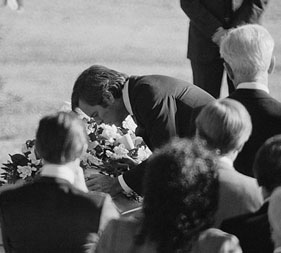
Robert Wagner bends over to kiss the casket of his wife at Westwood Memorial Park Cemetery in December 1981.
There are apparently other sources of new information on the circumstances surrounding Natalie Wood’s death 30 years ago. (See, eg: “Natalie Wood death: Detectives talked to owner of yacht” [ie the gentleman in Honolulu who bought the boat in 1986]; and “Natalie Wood case: witness feared for life … A potential witness claims she heard cries for help on the night of Natalie Wood’s drowning, but was afraid following a threatening note.”)
We will just have to wait and see what happens. At the moment, the official word from the Los Angeles County Sheriff’s Department is that Ms. Wood’s untimely and unhappy death is still being treated as an accident – until and unless the current further investigation reveals convincing reasons to alter that assessment. And, as noted at the start of this perhaps a little too long piece, for the moment John Gregory Dunne’s 2004 conclusion still seems convincing to me: “What happened will probably never be known. Everyone was too drunk, the two survivors assaulted by guilt and memories best forgotten.”
Meanwhile, I was pleased to see the now 81-year-old Robert Wagner playing the role of Tony DiNozzo’s somewhat wayward but charming father, on the latest episode of what I understand is the current most popular drama series on US TV, NCIS – starring the great Mark Harmon and the beautiful Cote de Pablo, etc, etc. As others have noted, it was ironic that Wagner was playing a character who some felt should be charged with murder. The fact that he was finally proved innocent is, I would guess, a clue to the truth about the real RJ in the death of the wife I do believe myself he loved quite deeply, in spite and even because of everything.
Finally, like others again, I was amused to read in this past Friday’s Toronto Star an article headlined “Newsmangled: Radio show’s Christopher Walken impersonation fools Associated Press.” Marc Sterne, who does a “regular Walken” imitation on the ESPN sports radio program The Tony Kornheiser Show, recently phoned into the same place with some phony alleged Christopher Walken comments on the night that Natalie Wood died. For long enough the Associated Press fell for the story. I for one will be remembering this the next time I hear about any further information on what happened off Santa Catalina, island of romance, on the tragic early morning of November 29, 1981. And, just in case one or two people accidentally care, I would advise everyone else who is listening to do the same!
UPDATE – WEDNESDAY, JANUARY 11, 2012: The mainstream media are now reporting that “Natalie Wood probe yields no new evidence … Detectives say there’s nothing to suggest that her death while sailing off Santa Catalina Island in 1981 was anything but accidental” and “Detectives find no evidence of foul play in Natalie Wood’s death.” Who knows what this exercise really is or has been all about? Whatever, many of us are happy to be thinking of Natalie Wood again – and maybe that actually is the ultimate point!
UPDATE – WEDNESDAY, AUGUST 22, 2012: It seems that the plot has thickened at least somewhat over the past several months, though not in any definitive way. According to the Associated Press: “Natalie Wood’s death certificate amended by coroner … Natalie Wood’s death certificate has been changed to reflect some of the uncertainties and lingering questions surrounding the actress’ drowning more than 30 years ago in the Pacific Ocean off Southern California … The document was amended earlier this month and shifts Wood’s death from an accidental drowning to ‘drowning and other undetermined factors,’ according to a copy of the certificate obtained Tuesday by The Associated Press … The amended document also now states that the circumstances of how Wood ended up in the waters off Catalina Island in November 1981 are ‘not clearly established’ … The changes occurred nine months after sheriff’s homicide investigators renewed their inquiry into Wood’s death shortly before its 30th anniversary.“
TUESDAY, NOVEMBER 29, 2016 : Some aspects of all this continue. The mystery remains unsolved, as it probably always will. Â For developments 35 years after Ms Wood’s sad death see L. Frank Bunting on “Splendor at the Hollywood theatre with Natalie Wood .. five years later (when she would be 78 years old).”
